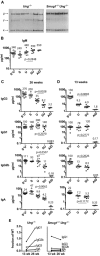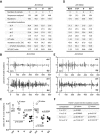Uracil excision by endogenous SMUG1 glycosylase promotes efficient Ig class switching and impacts on A:T substitutions during somatic mutation
- PMID: 24771041
- PMCID: PMC4158878
- DOI: 10.1002/eji.201444482
Uracil excision by endogenous SMUG1 glycosylase promotes efficient Ig class switching and impacts on A:T substitutions during somatic mutation
Abstract
Excision of uracil introduced into the immunoglobulin loci by AID is central to antibody diversification. While predominantly carried out by the UNG uracil-DNA glycosylase as reflected by deficiency in immunoglobulin class switching in Ung(-/-) mice, the deficiency is incomplete, as evidenced by the emergence of switched IgG in the serum of Ung(-/-) mice. Lack of switching in mice deficient in both UNG and MSH2 suggested that mismatch repair initiated a backup pathway. We now show that most of the residual class switching in Ung(-/-) mice depends upon the endogenous SMUG1 uracil-DNA glycosylase, with in vitro switching to IgG1 as well as serum IgG3, IgG2b, and IgA greatly diminished in Ung(-/-) Smug1(-/-) mice, and that Smug1 partially compensates for Ung deficiency over time. Nonetheless, using a highly MSH2-dependent mechanism, Ung(-/-) Smug1(-/-) mice can still produce detectable levels of switched isotypes, especially IgG1. While not affecting the pattern of base substitutions, SMUG1 deficiency in an Ung(-/-) background further reduces somatic hypermutation at A:T base pairs. Our data reveal an essential requirement for uracil excision in class switching and in facilitating noncanonical mismatch repair for the A:T phase of hypermutation presumably by creating nicks near the U:G lesion recognized by MSH2.
Keywords: Class switching; DNA deamination; Somatic hypermutation; Uracil.
© 2014 The Authors. European Journal of Immunology published by WILEY-VCH Verlag GmbH & Co. KGaA, Weinheim.
Figures





Comment in
-
Refining the Neuberger model: Uracil processing by activated B cells.Eur J Immunol. 2014 Jul;44(7):1913-6. doi: 10.1002/eji.201444813. Epub 2014 Jun 30. Eur J Immunol. 2014. PMID: 24920531 Free PMC article.
Similar articles
-
Refining the Neuberger model: Uracil processing by activated B cells.Eur J Immunol. 2014 Jul;44(7):1913-6. doi: 10.1002/eji.201444813. Epub 2014 Jun 30. Eur J Immunol. 2014. PMID: 24920531 Free PMC article.
-
SMUG1 is able to excise uracil from immunoglobulin genes: insight into mutation versus repair.EMBO J. 2006 Feb 8;25(3):585-95. doi: 10.1038/sj.emboj.7600939. Epub 2006 Jan 12. EMBO J. 2006. PMID: 16407970 Free PMC article.
-
Mismatch recognition and uracil excision provide complementary paths to both Ig switching and the A/T-focused phase of somatic mutation.Mol Cell. 2004 Oct 22;16(2):163-71. doi: 10.1016/j.molcel.2004.10.011. Mol Cell. 2004. PMID: 15494304
-
Uracil in DNA--general mutagen, but normal intermediate in acquired immunity.DNA Repair (Amst). 2007 Apr 1;6(4):505-16. doi: 10.1016/j.dnarep.2006.10.014. Epub 2006 Nov 20. DNA Repair (Amst). 2007. PMID: 17116429 Review.
-
Opinion: uracil DNA glycosylase (UNG) plays distinct and non-canonical roles in somatic hypermutation and class switch recombination.Int Immunol. 2014 Oct;26(10):575-8. doi: 10.1093/intimm/dxu071. Epub 2014 Jul 3. Int Immunol. 2014. PMID: 24994819 Free PMC article. Review.
Cited by
-
Repair of programmed DNA lesions in antibody class switch recombination: common and unique features.Genome Instab Dis. 2021;2(2):115-125. doi: 10.1007/s42764-021-00035-0. Epub 2021 Mar 26. Genome Instab Dis. 2021. PMID: 33817557 Free PMC article. Review.
-
SAMHD1 enhances immunoglobulin hypermutation by promoting transversion mutation.Proc Natl Acad Sci U S A. 2018 May 8;115(19):4921-4926. doi: 10.1073/pnas.1719771115. Epub 2018 Apr 18. Proc Natl Acad Sci U S A. 2018. PMID: 29669924 Free PMC article.
-
Proximity to AGCT sequences dictates MMR-independent versus MMR-dependent mechanisms for AID-induced mutation via UNG2.Nucleic Acids Res. 2017 Apr 7;45(6):3146-3157. doi: 10.1093/nar/gkw1300. Nucleic Acids Res. 2017. PMID: 28039326 Free PMC article.
-
MBD4 Facilitates Immunoglobulin Class Switch Recombination.Mol Cell Biol. 2017 Jan 4;37(2):e00316-16. doi: 10.1128/MCB.00316-16. Print 2017 Jan 15. Mol Cell Biol. 2017. PMID: 27777312 Free PMC article.
-
Chicken MBD4 Regulates Immunoglobulin Diversification by Somatic Hypermutation.Front Immunol. 2019 Nov 1;10:2540. doi: 10.3389/fimmu.2019.02540. eCollection 2019. Front Immunol. 2019. PMID: 31736964 Free PMC article.
References
-
- Honjo, T., Kinoshita, K. and Muramatsu, M., Molecular mechanism of class switch recombination: linkage with somatic hypermutation. Annu. Rev. Immunol. 2002. 20:165–196 - PubMed
-
- Di Noia, J. M. and Neuberger, M. S., Molecular mechanisms of antibody somatic hypermutation. Annu. Rev. Biochem. 2007. 76:1–22 - PubMed
-
- Rada, C., Ehrenstein, M. R., Neuberger, M. S. and Milstein, C., Hot spot focusing of somatic hypermutation in MSH2‐deficient mice suggests two stages of mutational targeting. Immunity 1998. 9:135–141 - PubMed
Publication types
MeSH terms
Substances
Grants and funding
LinkOut - more resources
Full Text Sources
Other Literature Sources
Molecular Biology Databases
Miscellaneous

